
Impact craters almost always start out as circular structures bounded by a raised rim and bottomed by a depression which may have a central uplift or peak (exception to roundness is the elliptical form that occur when a crater strikes at a very low incidence angle). As crater diameter increases, the ratio of depth to diameter decreases. Crater morphology is altered with time as erosion (mainly by water on Earth and by repeated subsequent impacts and buried by ejecta on the Moon) tends to subdue its topographic expression. As craters wear down to scars (astroblemes) in the bedrock, their initial circularity may still have an effect on drainage. Buried craters are sometimes identifiable by their patterns in seismic or gravity surveys. In situ features of craters include shatter cones and breccias. This page also describes several very large craters whose after effects may have altered conditions for life on Earth.
Craters come in three shape/size categories: 1) Simple; 2) Complex; 3) Basins. The difference between the first two is evident in this diagram (Complex craters have a central peak and terraces along their walls, resulting from slumping along concentric fractures.)

Generally, simple craters are less than 20 km in diameter and complex ones are wider in diameter. Basins, which are several hundred kilometers or more in diameter, may also have central peaks but these can be completely submerged because these big craters can induce widespread crustal or mantle melting that fills them up. In the upper diagram, the top of the red area (the lens of the fall back and slump breccia fill) is known as the surface of the apparent crater (what one sees looking into the crater. i.e., the top of the ejecta and/or some solidified melt [caused by shock and/or by subsequent invasion by activated lava from below]); the bottom of the red area is the boundary of the true crater (the limit of excavation by the cratering process, below which the country rock is intact although fractured).
We will use three lunar impact structures to illustrate the three types - Simple, on top; Complex, in middle; Basin, at bottom:
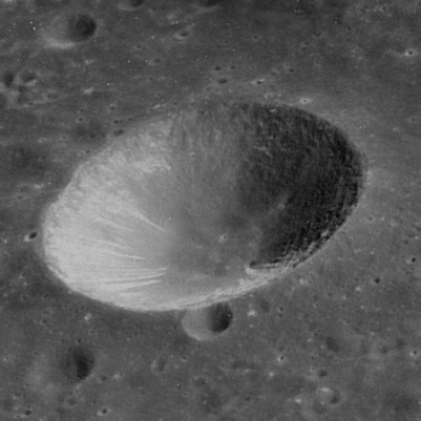
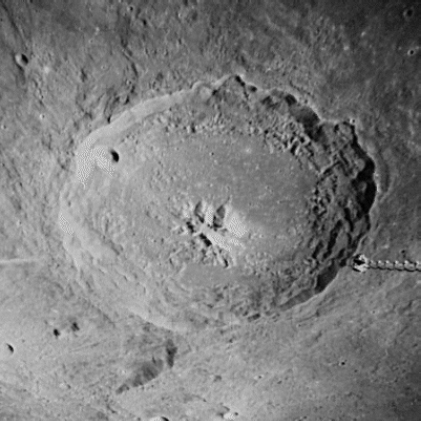
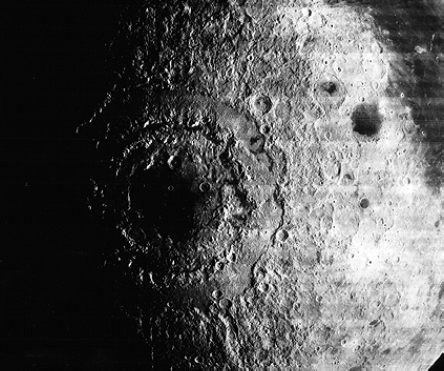
When craters are exposed at the surface, the younger, usually less eroded ones are recognized by their morphology or external form. They are approximately circular (unless later distorted by regional deformation), have raised rims, show structural displacements in their wall rocks, and may have a central peak, consisting of rocks raised from deep original positions. We can emphasize the morphology of these craters in 3-D perspectives (commonly using Digital Elevation Map data) of their contours, exaggerating the elevations and applying shading or artificial illumination (computer-controlled). An example of how this makes craters more obvious, when today they often have low relief, is the Flynn Creek structure (3.5 km [2.2 mi] wide) in Tennessee:
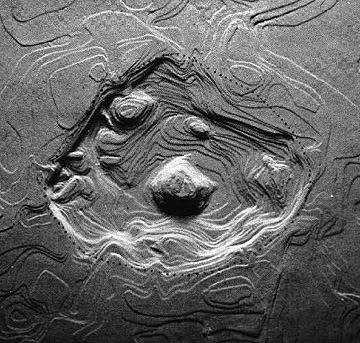
The structural deformation in the affected rock immediately beyond the crater boundary is usually intense and distinctive. Initially flat-lying layers of sedimentary rocks near the surface, beyond the rim, are commonly deformed by upward bending (layers inclined downward [dip] away from the crater walls). Anticlines may be formed or in the extreme the layers are completely overturned producing a flap in which the top layers are upside down, flipped over on top of layers farther out. Modes of layer deformation at two impact craters and one nuclear explosion crater are shown in this diagram (the term "authigenic breccia" refers to fragments (clasts) formed in place with little or no transport; "allogenic breccia" refers to fragments that were broken up elsewhere and then transported to their present sites.
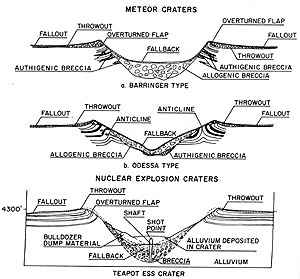
The term "overturned flap" warrants an example. Mapping at the Sedan nuclear crater was particularly revealing about this unusual deformation. Look at this cross-section of the area just beyond the crater:
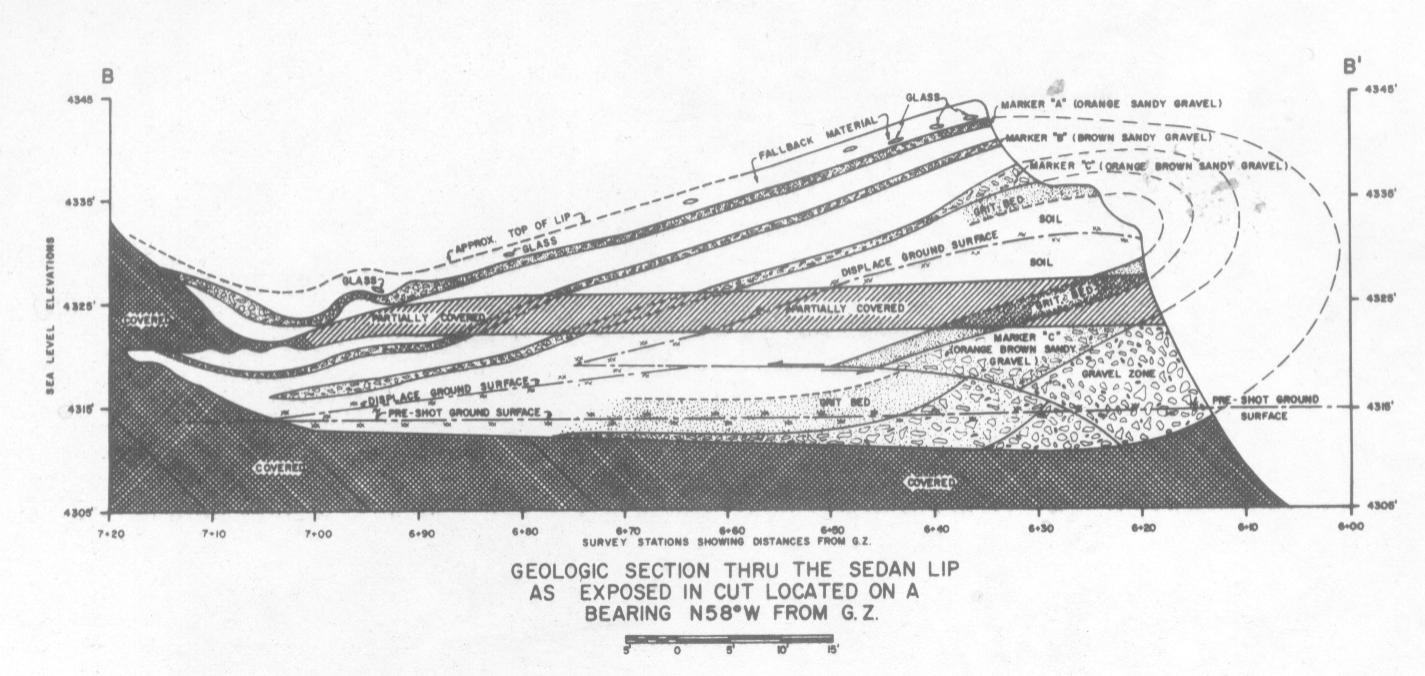
There were several distinct layers in the Sedan alluvium that could be used as markers. The cross-section reveals that as the crater deformation proceeded, these layers were completely folded back on themselves (overturned) for nearly 100 meters. When the writer (NMS) visited the mapped area, he was shown where an asphalt road leading up to the pre-detonation drill hole that emplaced the nuclear device was flipped over onto itself. Amazing!
Deformation involving bending and overturning is well exposed in the layered limestones exposed by quarrying at the Kentland, Indiana impact structure:
This structure involves deformation of an area up to 13 km wide in a region where all other rocks are still horizontal. Shatter cones, coesite, and other shock feature provide the proof that this is the remnant of an impact crater.
One of the most famous, and best studied, large complex craters is the the 24 km (15 mi) wide Ries Kessel (also referred as the Nordlinger Ries or just plain Ries) in Bavaria. (An Internet site [in German] that provides more information and field photos is sponsored by the Ries Museum of Nordlingen). Here is a photo montage (made by piecing together several wide-angle lens photos) of part of this structure. (On one of its rim units, thick largely evergreen forests develop, whose dark appearance helps to outline the structure; the occurrence of clouds over this unit appears to result from local evapotranspiration from trees.)
And here is a DEM reconstruction of its generalized subsurface structure:
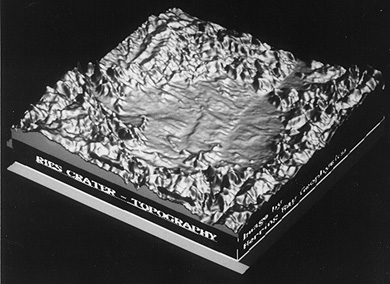
18-6: In the Ries Kessel perspective view, the crater appears surrounded by mountains. But in reality, the actual landscape is hilly but not mountainous. Explain the illusion. ANSWER
In satellite images, the Ries structure is not easy to spot. Its interior depression has been backfilled and its rim is now notably eroded. But analysis of its topography using elevation data extracted from ASTER data on Terra brought out the still surviving circularity of the crater, as seen in this bottom view (the top view is an ASTER pseudo-natural color image in which the circularity is obscured but to some degree hinted at):
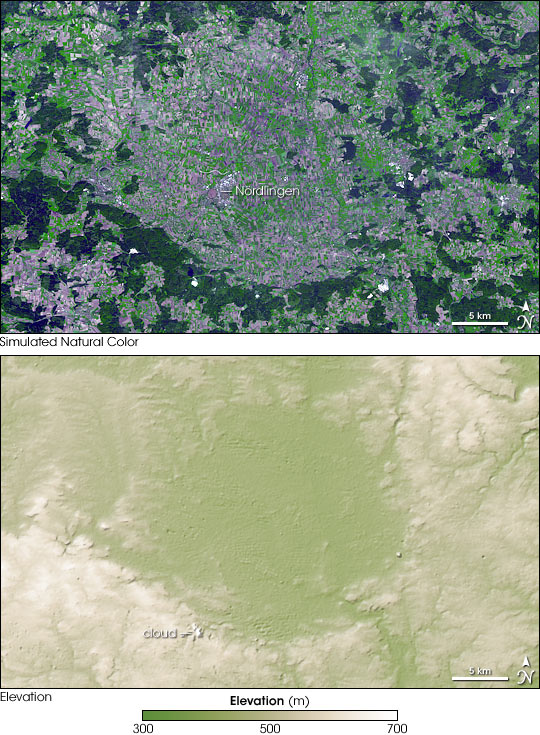
The geologic nature of the present, somewhat eroded Ries structure is encapsulized in this cross-section
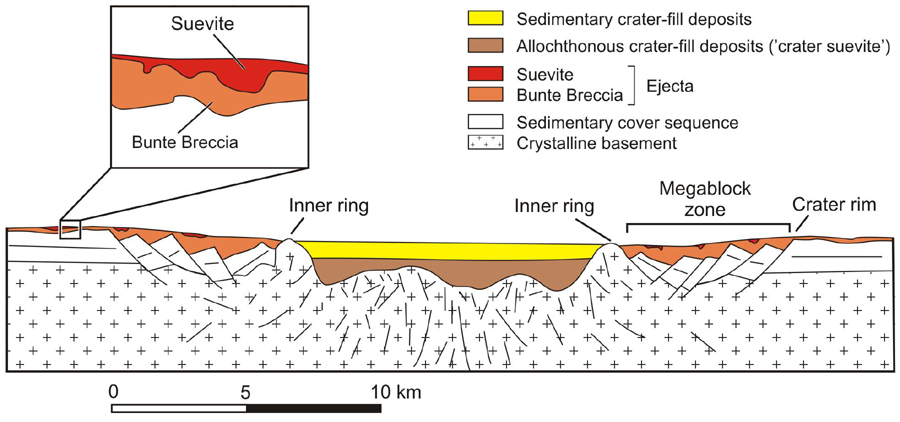
The Ries is young enough for much of the ejecta that deposited in thick units (when consolidated the general term "breccias" applies; at the Ries the special name "Suevite" is given to this rock) to still be preserved. Here is some field outcrops:
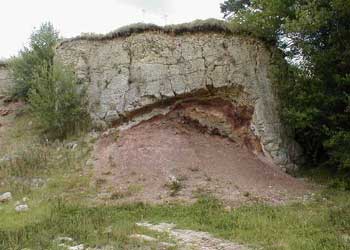
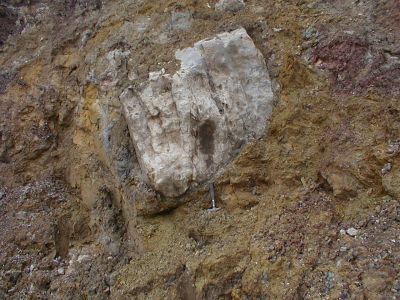
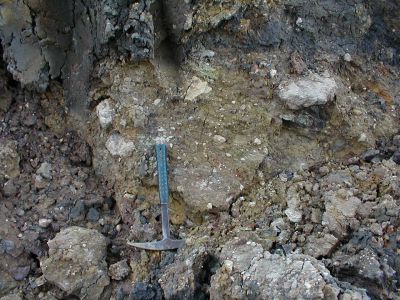
The Ries lies astride "Das Romantische Weg" - The Romantic Way - made up of towns and cities that have preserved much of their medieval buildings. Within the Ries is a remarkable small town, Nordlingen, surrounded by a protective wall. Here is an aerial view of this marvelous throw-back to another era:

Since medieval times, the local residents in Nordlingen quarried some of the breccia deposits that had hardened into rock. This was used as building stone. The Catholic Church near the center of this walled city is made up of this Suevite rock; unfortunately, the rock is easily weathered (because it contains much glass that is unstable over time), so that the Church today is in constant need of repair. Here is this Church:
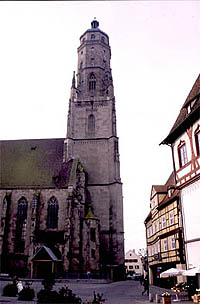
Some of the ejecta "clasts" at the Ries are as big as a house. Megabreccias, similar to those found on the lunar highlands (Section 19), are not uncommon at terrestrial impact structures. A striking example is exposed along a cliff next to a lake inside the Popigai impact crater in Siberia:
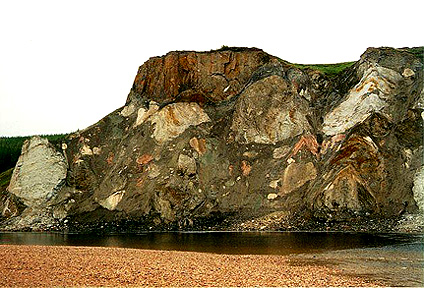
Simple craters (and some larger ones) often have depressions that fill with water. On the top below is an aerial view of the 3.5 km (2.2 mi) wide New Quebec crater (renamed Pinqualuit crater) in granitic shield rock, exposed in Northern Quebec; at the bottom is a view from space.
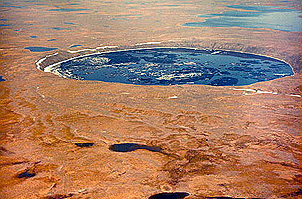
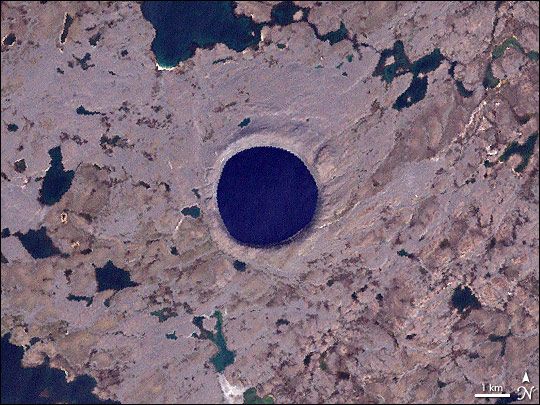
The West Hawk Lake structure (2.5 km [1.6 mi] diameter) formed in metamorphic rocks in westernmost Ontario near the line with Manitoba was the first impact crater studied in detail by the writer [NMS], in 1965; the details were published in 1966 in the Bulletin of the Geological Society of America.
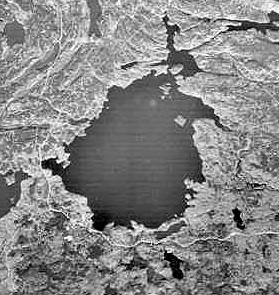
In Canada, and other northern latitude countries, lakes filling impact structures, such as at West Hawk Lake, freeze in winter, allowing support for drill rigs, so that scientists can explore the crater infill materials by recovering core. One observation from this study was that the distribution of shock effects (mainly planar features and the degree of isotropization) varied rather nonsystematically within the breccia deposits. To quantify this, the writer developed the concept of a "shock log" which plots variations in shock damage as a function of depth; the shock metamorphic features (see next page) used to determine the level of shock damage are given in the key below the plot:
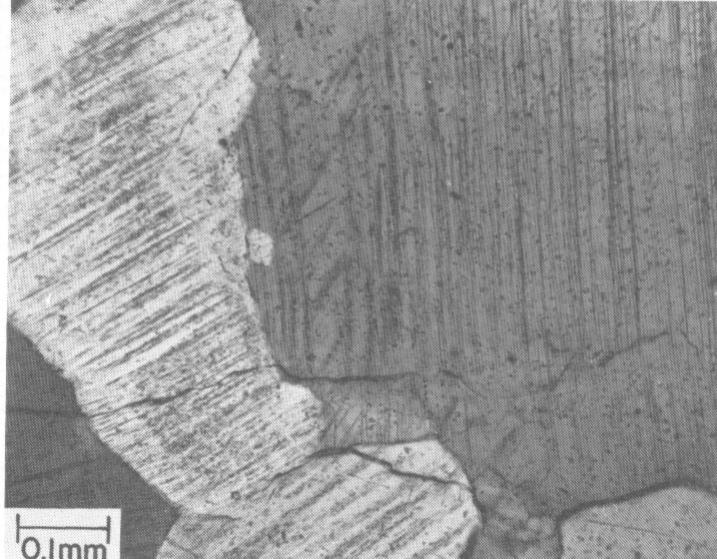
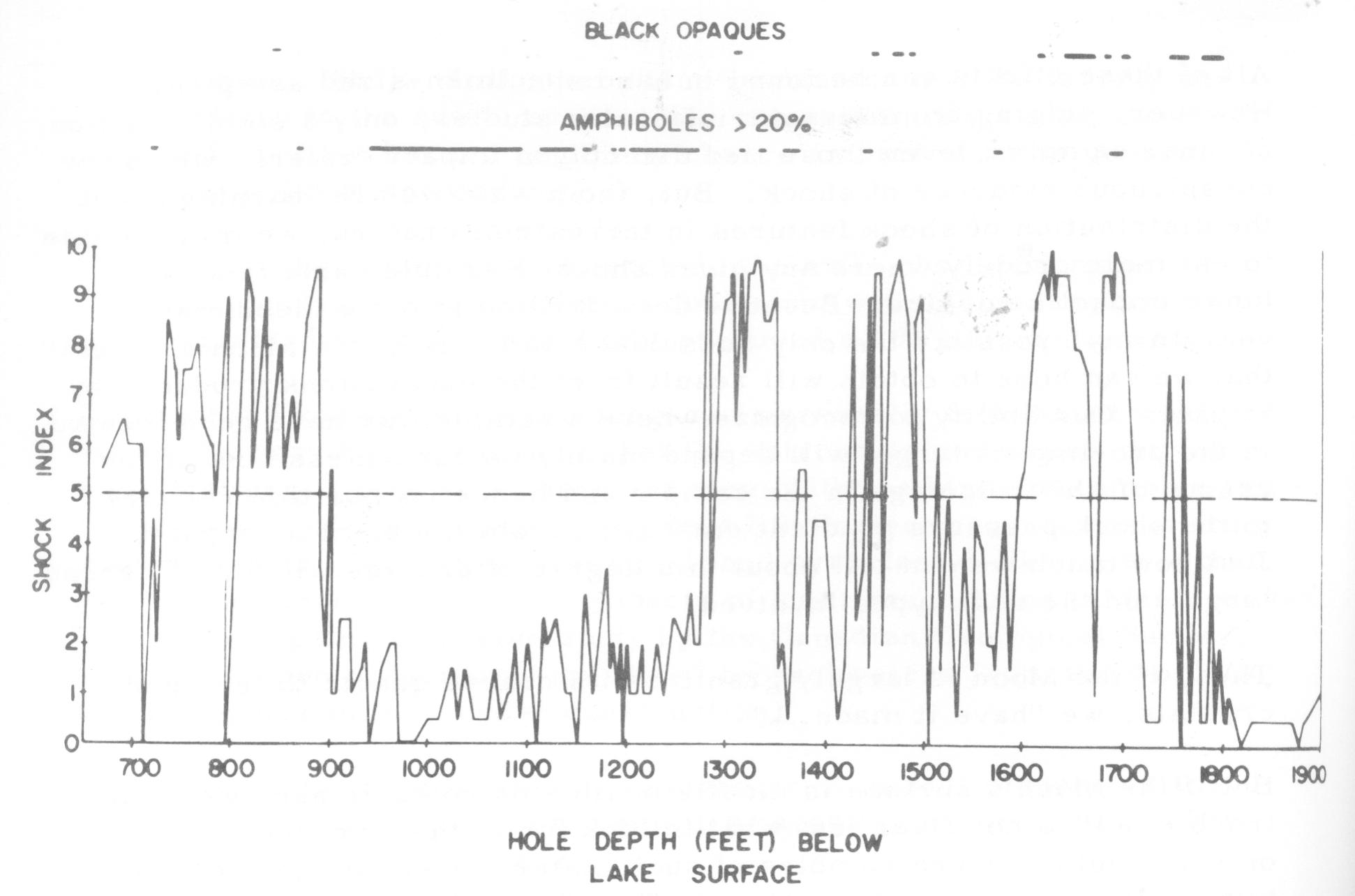
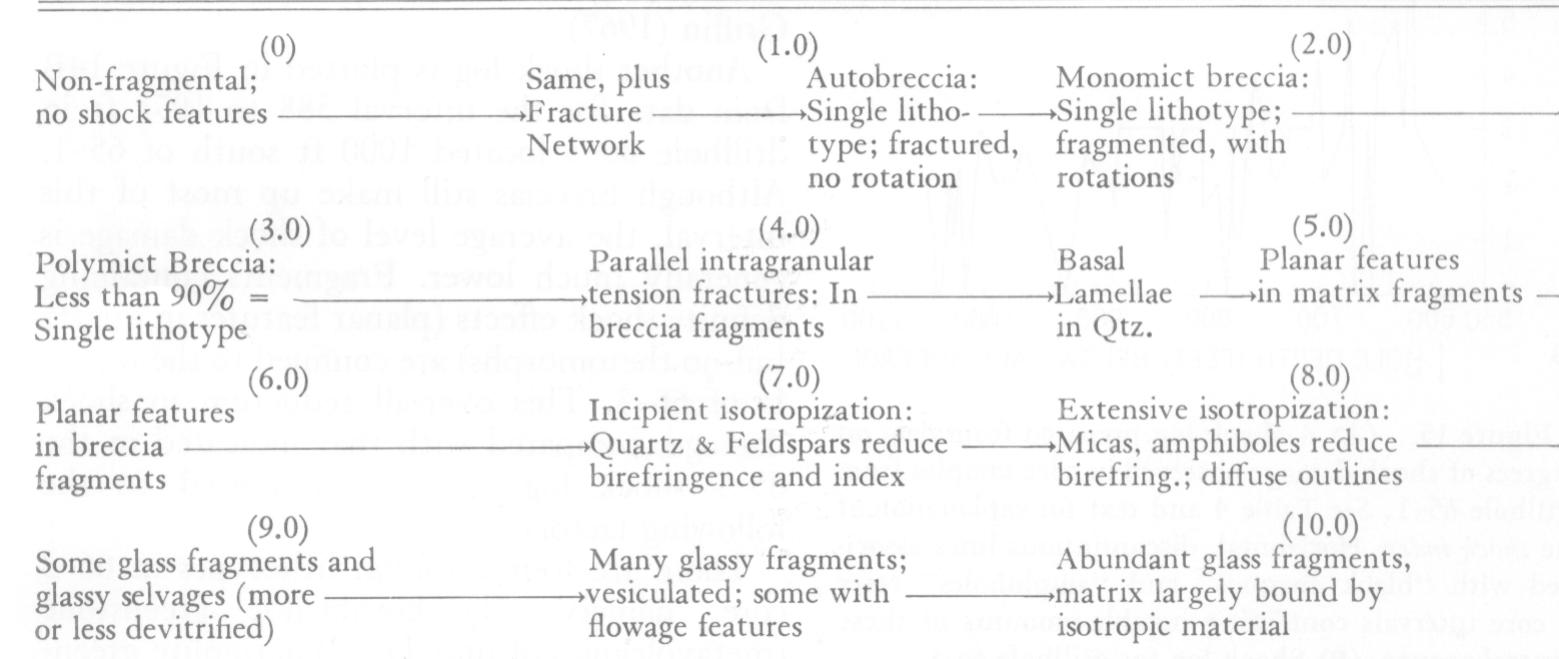
A spectacular complex crater is Manicouagan, a 100 km (62 mile) structure in southern Quebec, Canada, which has a great central peak area of igneous and metamorphic rocks, among which are feldspar-rich rocks. In these rocks, much of the feldspar has transformed by shock into glass, known as Maskelynite. Similar to Manson, there is a depression or moat between the peak and rim (now eroded) that formed annular valleys, which filled with water when a hydroelectric power dam blocked the draining rivers. Because of this contrasting surface expression, astronauts journeying back from the Moon could see this crater from well out in space.
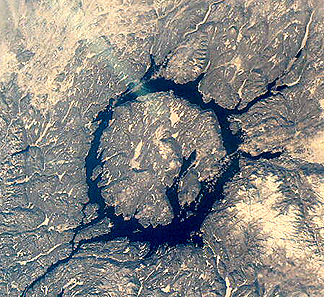
A great deal of impact-produced melt is found along the lake at Manicouagan, as shown here:
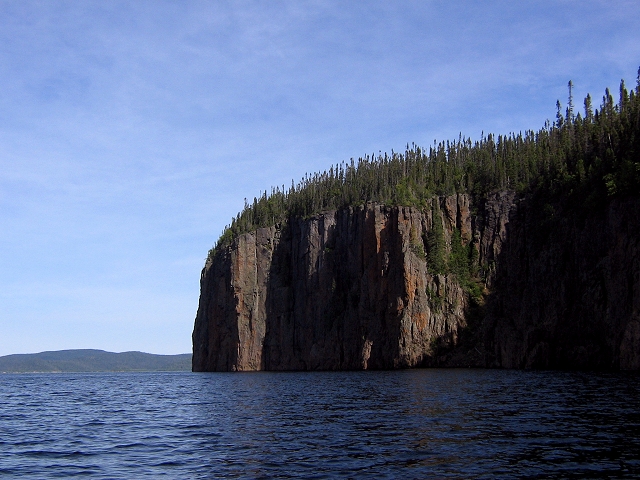
Deposits of fragmental rock surround most younger craters. An example (top, below) of such rock , from an outcrop at the Ries crater, illustrates these ejecta deposits (Suevite breccias). A second example (bottom) seen in core from a drilling that penetrated the Manson central peak, shows the diverse nature of the rock types making up these breccia fragments (called clasts).
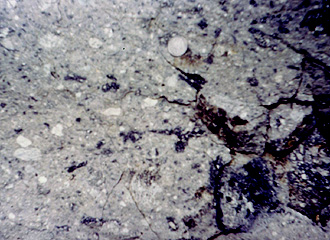
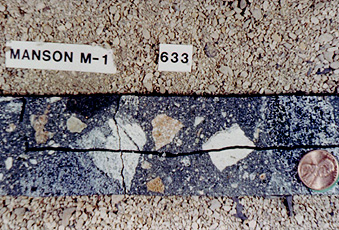
18-7:Suppose a continuous length of drill core consists of first an interval of breccia much like that shown in this figures, then a 10 meter interval of a single rock type, say granite, and followed by more small fragmental breccia. What explains this? ANSWER
Most ejecta blocks found around younger craters consist of fragmented bedrock derived from subsurface units. There can be exceptions if the surface material is unconsolidated. The writer (NMS) discovered a fabulous example of this, which at first was discounted by other specialists in this field. The crater is the small Wabar structure (there are 3 craters - 2 are small - there). in the sandy desert of southern Saudi Arabia. Around the rim are small fragments of white quartz sand, many coated with a black glass. Here is two views:
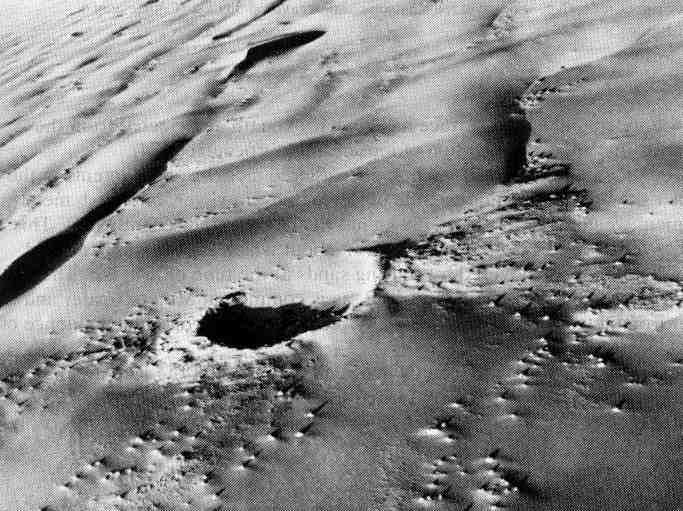
A few years earlier the writer had been given small pieces of "sandstone" around chemical explosion craters formed during an experimental program at the Nevada Test Site (NTS), where white loose quartz sand had been used to backfill the access hole through which the explosives were loaded. He postulated that the fragments were made up of this sand that had been driven together and compressed (a process he named "shock lithification", calling the fragments "instant rock"). He proposed the same origin for the Wabar fragments, namely, that they were desert sand shock-liithified by shock waves from the impact (and many were then covered by shock melt that overtook them). This pair of photomicrographs shows the texture of the NTS instant sandstone on the left and the Wabar lithified fragments on the right.
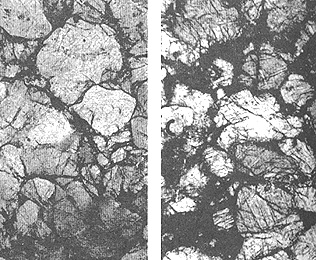
Below is a second photomicrograph of the NTS instant sandstone, showing more details.
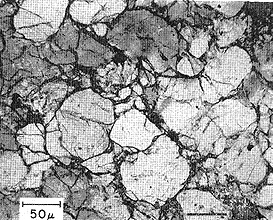
The paper on this interpretation was rejected by Science Magazine because the reviewer had been there and thought he had noted thin sandstone layers in the rim. Through a stroke of luck, the writer, telling a colleague at Shell Oil in Houston of the discrepancy in interpretation, was surprised to receive a call later from that friend who reported the loose sand at Wabar was more than 200 meters thick (he had asked a Shell field geophysical crew to run a seismic line next to the site; they determined an accurate thickness). With this new "proof" the paper was resubmitted to Science and was published.
Wabar not only has abundant examples of shock-lithified "sandstone", but it also has numerous samples of shock-melted sand as black glass:
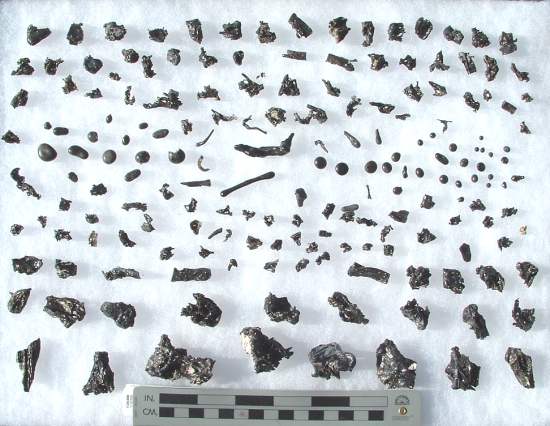
The writer obtained several Wabar samples which were "most peculiar". These consisted of the instant rock but with a thin coating on the exterior of this black glass (the bottom row above may show examples). Odd indeed! My speculation: the instant rock fragments were expelled as ejecta that passed through a "cloud" of the melted sand that made up the black glass. This is speculation but seems reasonable - I can't think of a better explanation. Strange things happen during impact events.
Eroded craters lack definitive external shapes, although the initial circularity may have a persistent effect on drainage, keeping streams in roughly circular courses. Such craters are often hard to detect but the presence of anomalous structural deformation and of brecciated rocks give clues. In rocks that were just outside the original wall boundaries (the true crater), a peculiar configuration, known as shatter cones, commonly develops.

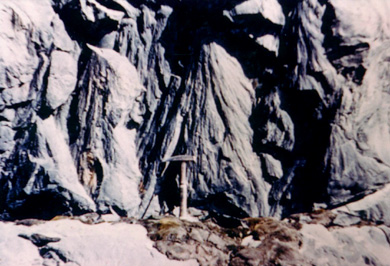
These "striated" conical structures (described as "horsetail"-like in shape) can be very small or can reach six feet or more in length, as seen above in quartzites at the Sudbury, Canada, impact structure. When the folded rocks containing the cones are restored to their original positions in an orientation graph, the cone apices invariably point toward an interior location that lies above the central crater floor. In effect, this denotes that the position where the energy was released was above the floor, a situation incompatible with a deep volcanic source, as once advocated by skeptics. The cones, which also sometimes form in rocks subjected to nuclear explosions, occur in lower (peripheral) shock pressure zones, as the rarefaction phase of the shock waves, spreading outward, places the rock into tensional stress. Many cones appear to originate from point discontinuities (e.g., a pebble) as though the waves were diffracted.
Shatter cones come in a range of sizes from a few centimeters to the 9 m cone at the Slate Island (Canada) impact structure, shown here:
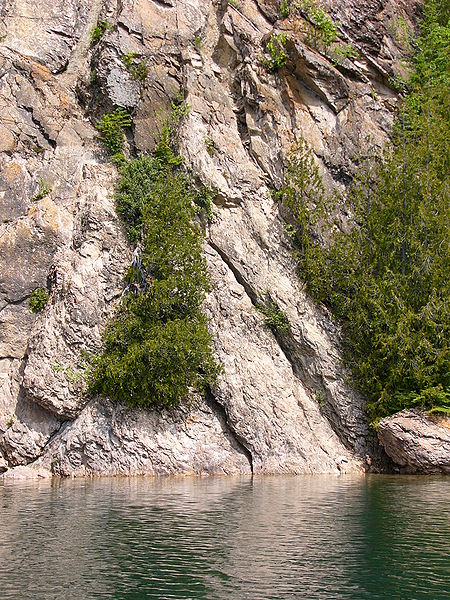
18-8: Try to explain what happens to cause the apex of a shatter cone to point towards the upper center of the crater near the point of impact. ANSWER
Still, the best evidence for a extraterrestrial origin of a crater is the survival of the incoming bolide as pieces of meteorites or asteroid/cometary material. This is relatively rare, although abnormal chemistry (such as iridium and other unusual concentrations of trace elements) in rocks and melt from older structures often can point to the intermixing of the bolide with the target. Iron meteorites are found in and around Meteor Crater, Arizona (see page 18-5). Iron meteorites are present in the small, relatively recent Campo del Cielo craters in South America and also at the Wabar crater discussed above. Eight small craters formed less than 10000 years ago in Poland near Poznan, with the largest being about 100 meters wide, were identified quite by accident as caused by large fragments of an iron meteorite, pieces of which were discovered by troops digging fortifications in World War I. The depressions are well-preserved, as seen in this photo:
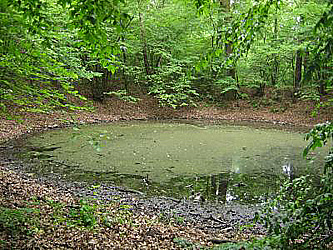
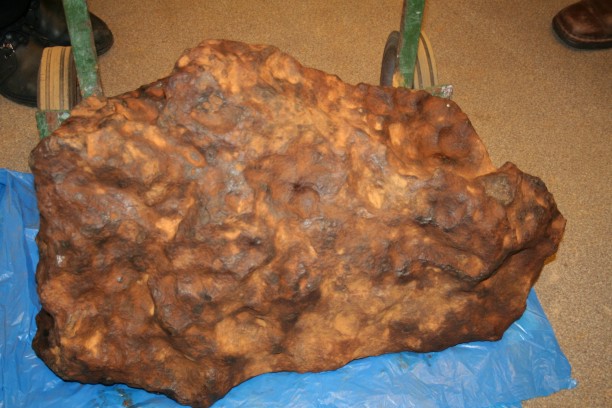
A word of caution: Lest one assume that every circular structure is impact in origin (we've already pointed out circular volcanic craters), here is a case where circularity on a grand scale does not mean a great impact event occurred. Consider the Nastapoka Arc on the eastern shore of Hudson's Bay in Canada, as seen in this Landsat mosaic:

Its circularity is imposing. Many hoped this was the largest impact structure on Earth. Possibly it may someday prove just that. But all the field evidence so far has not yield a single positive indicator of impact. Granted the surface rocks include some younger sedimentary cover. But no shatter cones have been found. The Belcher islands to the west show no shock features, expected if they were part of a central uplift. Limited deep drilling has not encountered shocked rocks. The circularity may simply be a fortuitous configuration of a sedimentary basin. But note the two circular features, side by side, to the east. These are the Clearwater Lakes impact structures, shown on the next page.
The Nastapoca Arc ambiguity calls attention to the fact that there are still other circular structures whose origins - impact, volcanic, tectonic - have been questioned. A case in point is the Upheaval Dome in Utah, seen here in this annotated astronaut photograph; for a long while this dome was considered to be the surface manifestation of some type of intrusion (perhaps a salt diapir):
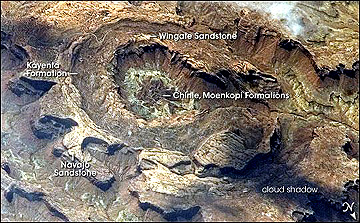
It was this structure that was studied by the Dean of Astrogeologists - Dr. Eugene Shoemaker - when he first worked for the USGS. He concluded that it could (?) be impact in origin. This aroused his interest in impact mechanics that eventually led him into planetary studies. For decades, the consensus disputed this origin. But recently several diagnostic shock features at the microscopic level have been discovered in its rocks, tipping the opinion balance in favor of a meteoritic collision.
Now on to a very relevant subject: Can impact craters, which represent huge releases of explosive energy, affect and even threaten life on Earth? Indeed, large impact craters - big enough to produce "basins" - are, of themselves, interesting to search for and study. But they also have important implications for the history of life on Earth. To determine whether impact plays such a role we start first with a quick overview of what is known about mass extinctions since life in its macroscopic form (large plants and animals) became abundant at the beginning of the Paleozoic. Consider this diagram:
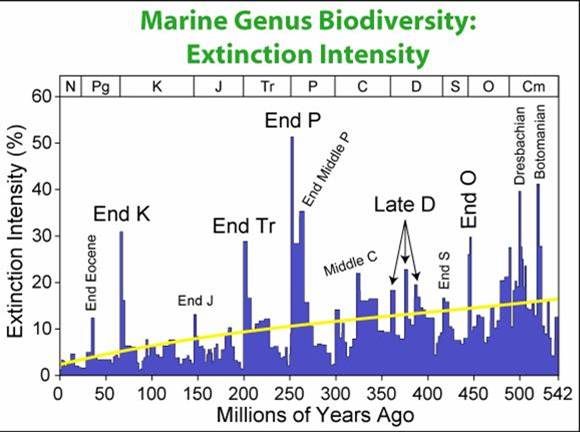
The diagram indicates that there have been many small extinction events during this time span, and a few larger ones. One of these is the famed demise of the dinosaurs at the Cretaceous-Tertiary boundary. Many geologists now believe that the biggest extinction of all ended the Paleozoic at the close of the Permian. Other mass extinctions affected large fractions of animal and plant life at the end of the Ordovician, the Devonian, the Triassic, and possibly the Paleocene.
These extinctions are best defined at the family level, as shown in the graph below, and the accompanying explanation beneath it:
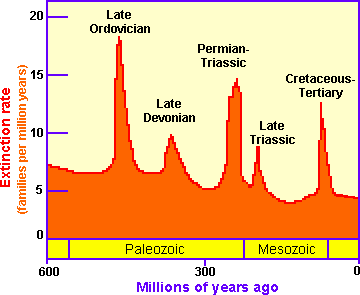
* The late Ordovician period (about 438 million years ago) - 100 families extinct - more than half of the bryozoan and brachiopod species extinct.
* The late Devonian (about 360 mya) - 30% of animal families extinct.
* At the end of the Permian period (about 245 mya) - Trilobites go extinct. 50% of all animal families, 95% of all marine species, and many trees die out.
* The late Triassic (208 mya) - 35% of all animal families die out. Most early dinosaur families went extinct, and most synapsids died out (except for the mammals).
* At the Cretaceous-Tertiary (K-T) boundary (about 65 mya) - about half of all life forms died out, including the dinosaurs , pterosaurs, plesiosaurs, mosasaurs, ammonites, many families of fishes, clams, snails, sponges, sea urchins and many others.
However, the above diagram tends to obscure the fact that extinctions are very common in the geologic record. At various times, the extent of extinction has been less than those associated with "mass extinctions" but in notable numbers nevertheless. Some researchers attribute at least one or more of these destructive occurrences to impact - although other mechanisms have been proposed (see bottom of page).
In the context of these known extinction events, can impact be demonstrated as the cause of at least one or more of these? Consider this diagram, which shows most of the extinction events, along with the time estimates of both major impact crater formation and several spans of major volcanic activity, from which you can draw your own conclusion: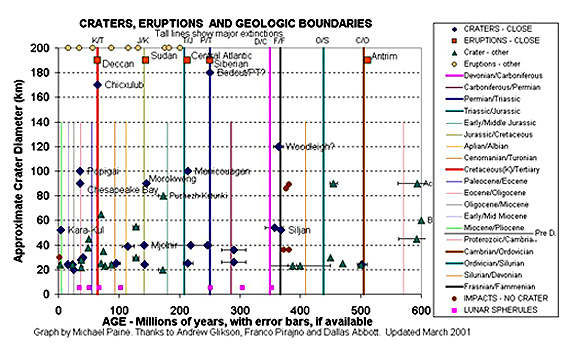
With this background re: mass extinction, let us examine the evidence that includes both impact cratering and volcanism as the most likely causes of the disappearance of life forms on a global scale. The discovery of a highly probable huge impact at the end of the Mesozoic Cretaceous period is now believed to have destroyed worldwide a large percentage of living forms (about 70%, mostly on the lands) including the dinosaurs.
Evidence for an impact catastrophe is best demonstrated by the K/T boundary (time horizon between the Cretaceous [K] and Tertiary [T]). The first important report of unusual features in deposits at the boundary was made by the father and son scientists Luiz and Walter Alvarez, based on studies they made of deposits at Gubbio, Italy and elsewhere:
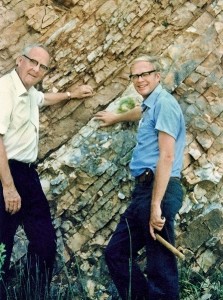
The Alvarez's deduced the nature of these deposits, and their significance, from the presence of Iridium, an element related to Platinum in the Periodic Table. Iridium is rare on Earth, but is found in minute amounts in some basaltic rocks. It is calculated to be much more abundant in the Earth's iron core. Iridium is a notable constituent in meteorites, mainly those composed primarily of iron or with iron inclusions. The Alvarez pair proposed that the Iridium in the K-T boundary layer deposits was part of the fallout of debris injected into the high atmosphere by a huge impact. They, and others, began to hunt for Iridium in deposits considered to be at the K-T boundary as recognized in various parts of the world. Many localities with Ir-enriched K-T layers have been found, as shown in this map:

The resulting debris from the reputed impact event was ejected into high altitudes spread around the globe and settled as a thin layer of material that marks the precise K/T boundary between the last rocks of the Cretaceous Period and the first sediments formed in the younger (overlying) Tertiary Period. The deposits contain Iridium, a metallic element related to Platinum present in many iron meteorites, in amounts far greater than can be accounted for by volcanic sources or other terrestrial rocks.
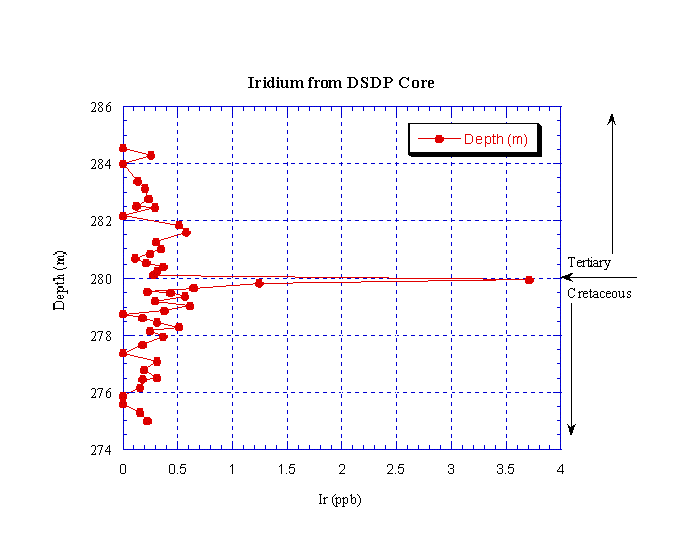
The deposits at the K-T boundary are usually very thin. They represent the fallout layer that may have been worldwide in distribution. Here is two examples of this now-famous layer, which also includes soot particles from the after-impact fires that consumed much of Earth's forests.
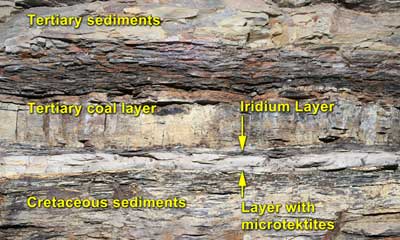
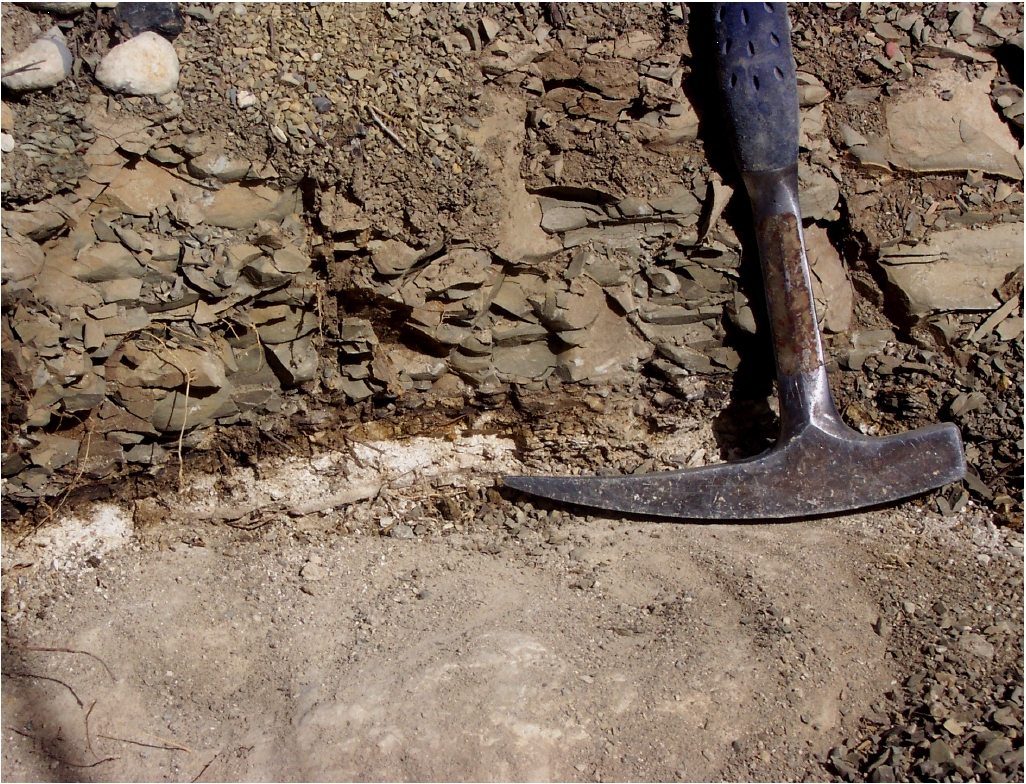
The immediate stratigraphy above and below the K-T time plane is quite distinctive. This cross-section for the Hell Creek locality in Montana is typical:

Below the K-T layer, sedimentary rocks are rich in fauna, both macroscopic (such as animals like the dinosaurs) and microscopic (such as plankton and other tiny marine life forms). The Tertiary rocks above the layer, for a few meters at least (representing several million years of deposition time), are missing most of these fauna, although some do carry over from the Cretaceous. This plot shows some of these characteristics:
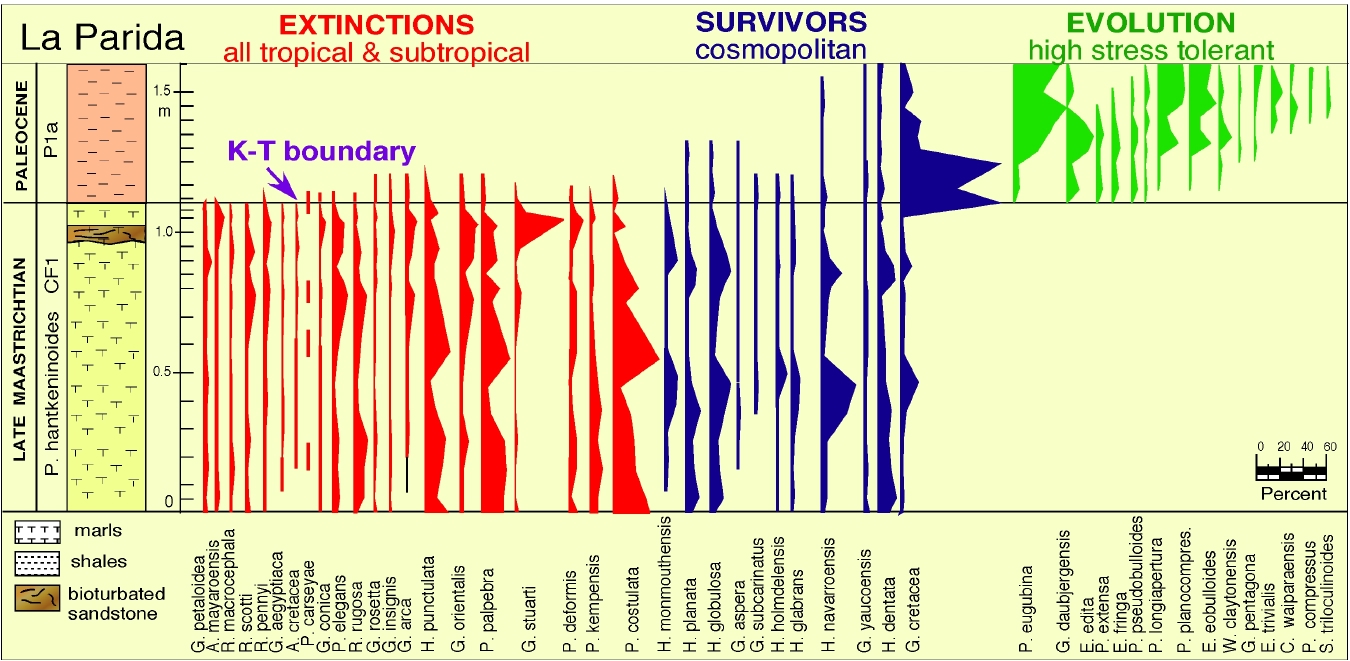
The nature of this abrupt change in faunal speciation and distribution has proved complicated. Suffice to say that some paleontologist dispute the claim of an abrupt disappearance of many fauna just above the boundary. Consult this Wikipedia web site for more details.
Soon after the Alvarez announcement, they and others presented evidence that shock features occur within the clay layers right at the boundary. The deposits usually contain small glass spherules, some similar to the tektites that have been generally accepted as evidence of impact. Here is an example.
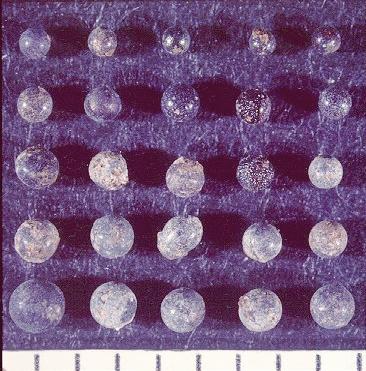
Some mineral grains found in the boundary layer bear evidence of intense shock (including quartz crystals with planar features; see page 18-4). Here are two example, the first in quartz and the second in a feldspar grain:
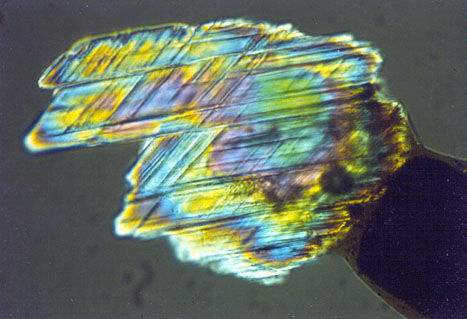
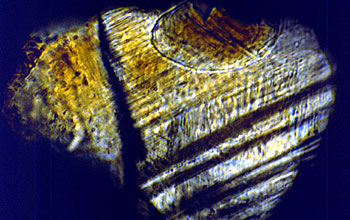
Although Iridium is sometimes spread into sediments by erosion of volcanic rocks that show somewhat larger concentrations, the very large amounts in the K-T layers, together with the shock features just shown (which are never produced from volcanic processes), have proved definitive in the association of the layers with fallout from an impact. The worldwide distribution of the Iridium implies a huge impact event. The question at the time was simply WHERE?
The killer impact site has now been found. In view of the tremendous energies involved, it is no wonder then that we classify the Chicxulub impact in the Yucatan Peninsula as one of the largest short-term natural events known in the geologic record (of nuclear-comparative magnitude in excess of 100 trillion tons of TNT equivalent). It occurred 65 million years ago and led to a 200-300 km (>150 mi) wide (there's still some uncertainty regarding the location of the outer rim) and perhaps 16 km (10 mi) deep depression. Here is its location:
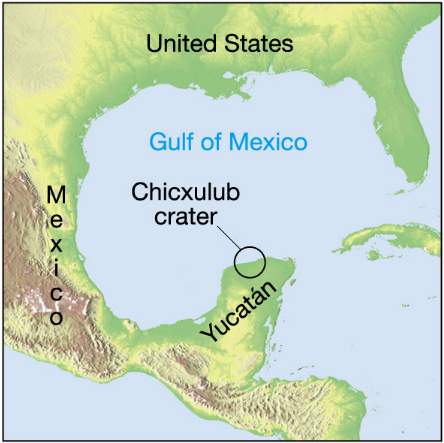
Satellite images of the Yucatan fail to disclose any sign of surface expression of the crater, mainly because the surface is almost completely masked in thick jungle vegetation. However, it does
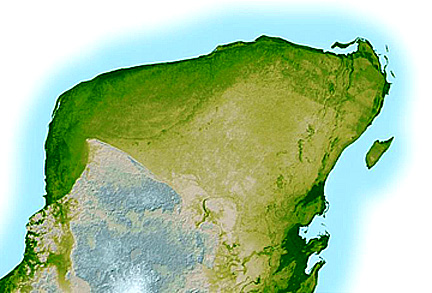
In case you missed this trace, here are a pair of images derived as an enlargement of the part of the Yucatan containing the Chicxulub crater. On the lower one, the rim boundary has been drawn in and the location of sink holes that seem to relate to subsurface control by the fallback material beyond the rim is marked.

When the effects of vegetation are compensated for, this huge structure has no evident surface expression, being covered by younger sedimentary rocks, but does appear subsurface as a strong gravity anomaly, with a definite circular pattern, as shown below.
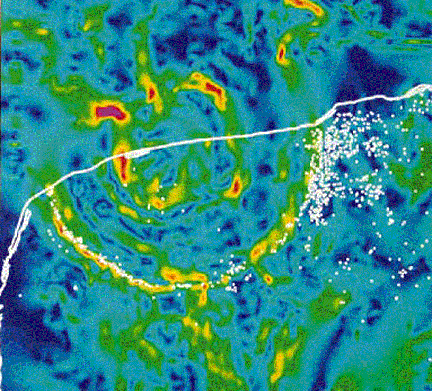
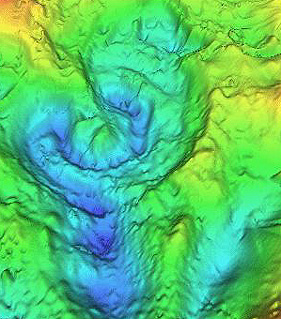
It was thought that Chicxulub could not be recognized in space imagery because of the post-impact sedimentary rocks covering the structure and also because of dense vegetation cover. However, radar data from the SRTM program have been specially processed to bring out otherwise subtle suggestions of the buried crater rim showing its presence by some manifestation at the surface (probably induced by differential subsidence). Here is that SRTM image of much of the Yucatan Peninsula. See if you can locate the rim trace:
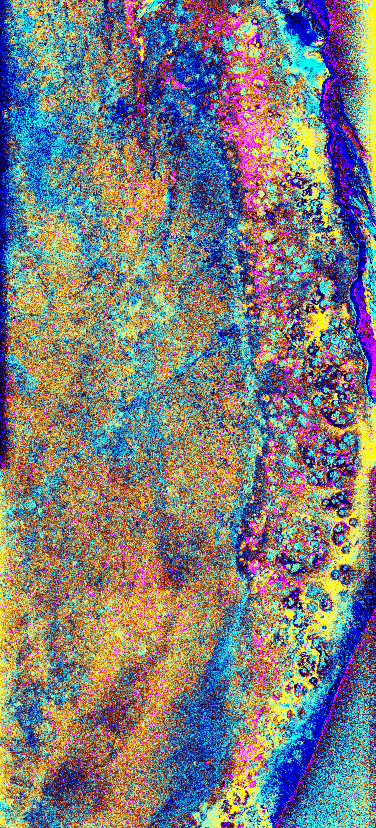
Evidence in the impact-related rocks (bedrock below the crater floor and ejecta within) was then discovered almost incidentally in core samples obtained through earlier exploration drilling for oil. The samples languished for years in the basement of the University of New Orleans' Geology Building, before someone re-examined them and deduced the origin of the anomalous materials beneath the post-impact sedimentary rocks. Intervals with these core samples, containing so-called volcanic rocks (now known to be shock-melted rock), showed distinct shock effects. These two stratigraphic sections, from two drill holes, present this interpretation.
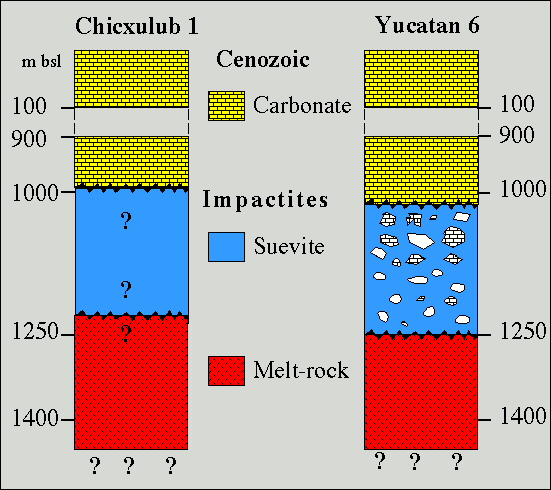
Quenched melt (glass), consistent with an impact event, has been recovered from drill core into Chicxulub; it contains fragments showing other evidence of shock damage:
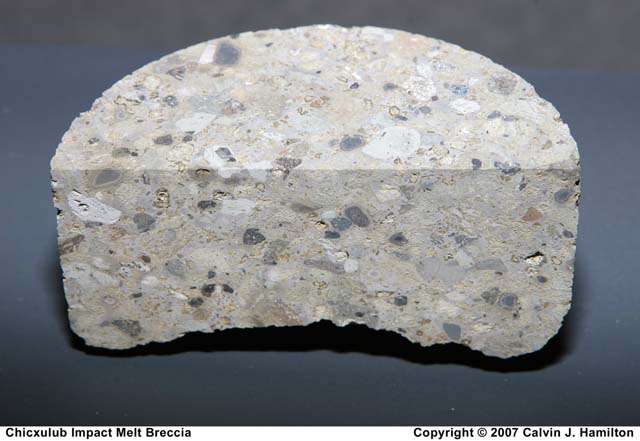
As interest in Chicxulub grew because of its apparent connection with the K-T boundary extinction, new evidence from its immediate vicinity and from deposits found at various distances in the U.S., Mexico, and Central America helped to confirm the impact hypothesis. This map shows some of the localities where deposits that could be tied to Chicxulub were found:
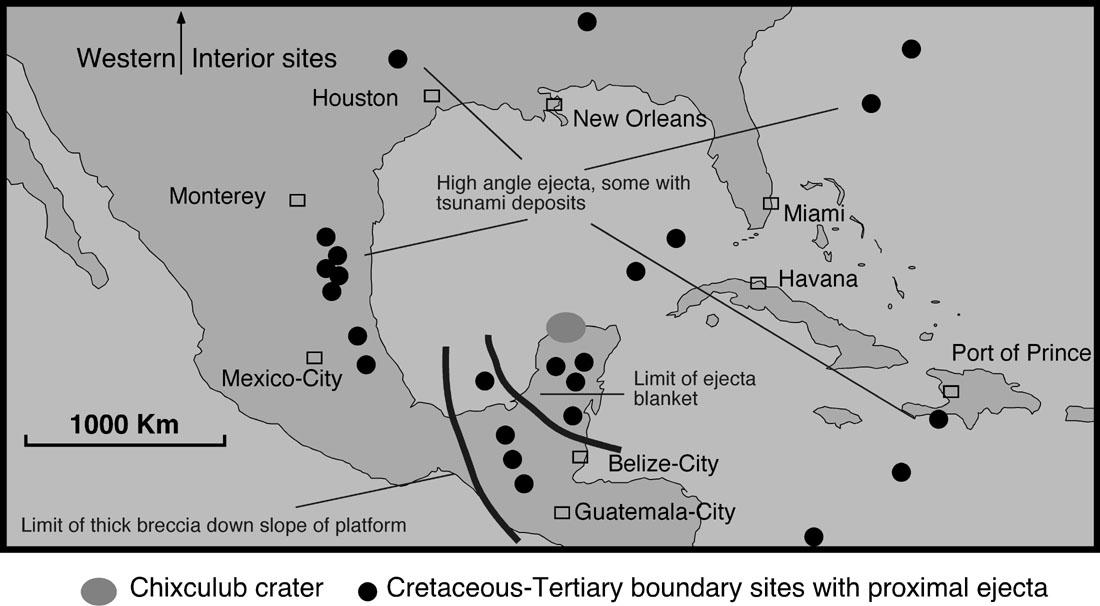
Ejecta deposits in Belize are definitely at the K-T boundary and show kinship with Chicxulub.
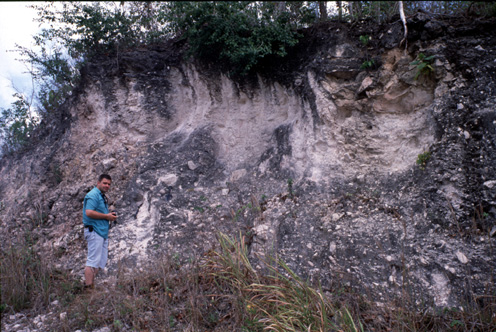
One of the consequences of the crater hypothesis is that the distribution of cenotes (Spanish for "sinkhole") in carbonate rocks could now be explained. This is evident in this map:
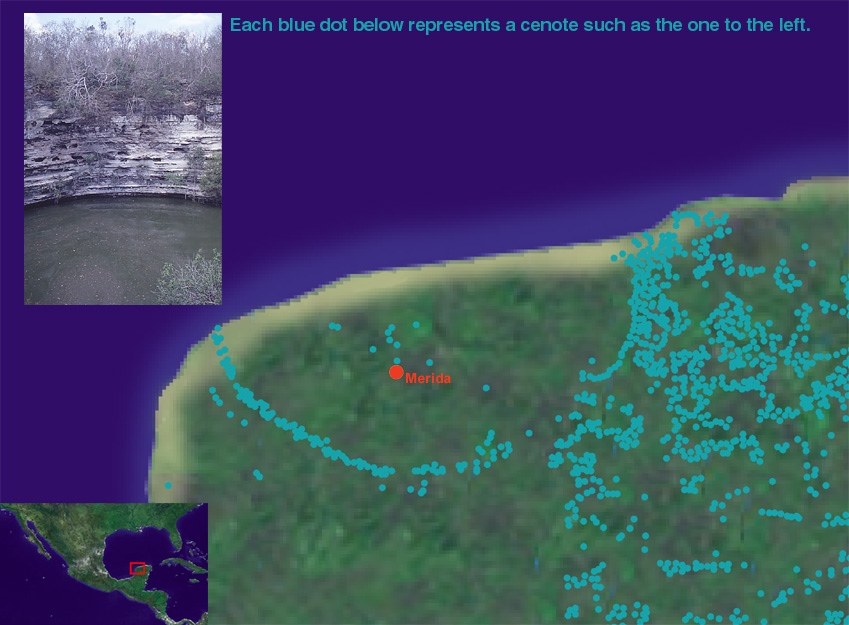
Some of the sinkholes were used by the Aztecs as ceremonial sites for killing rituals. This included several cenotes in the semi-circular ring that overlies the crater boundary, which had an effect on locating sinkholes outside the range where most were produced.
To summarize the Chicxulub event in terms of its almost certain relationship with the K-T boundary layers: The Chicxulub impact into shallow waters of the Gulf of Mexico generated huge waves (tsunamis) and, even more destructive to the planet, tossed enormous amounts of hot rock and water/stream into the atmosphere. An immediate result was to set forests and grasslands over much of the globe on fire, in the biggest firestorm in history. These materials, in turn, caused a worldwide "cloud deck" of aerosols, gases (including SO2) and particulates leading to temperature fluctuations, general darkening, an anoxic (oxygen-poor) atmosphere and reduced photosynthesis that wiped out much of the food chain and provided the "coup de grace" to the reduced number of dinosaur families still living then on Earth. Up to 50% of angiosperm (flowering plants) species were destroyed along with many animal families in the sea and on land. Some have estimated that it took thousands to a million or more years for ecosystems to recover. Mammals, inconspicuous before this event, were able to flourish in these restored systems and gradually gain ascendancy during the Cenozoic; this led the way for the eventual appearance of humans. For even more information on the now famous Chicxulub crater, go to this Wikipedia web site.
One could almost predict that once a strong candidate for the impact crater that killed the dinosaurs had been found, others would propose another crater that seems to fit the bill. The Shiva structure off the west coast of India in the Indian Ocean has been offered up as either an alternative to Chicxulub or in the view of some a second crater formed either at the same time or as a separate unrelated event very close in time to the Mexican crater and the K-T event. The structure is huge: some 650 by 400 km in dimension (this asymmetry suggest a glancing or low angle impact). It is still known only from geophysical evidence since it is under water and is topped by younger sedimentary material. But drill core (justified as exploration for oil) has returned brecciated rocks that date close to the K-T event. Its chief advocate is Prof. S. Chatterjee of Texas Tech University, who claims that rocks recovered from the site contain both shock features and high concentrations of Iridium. He notes the association of the event with the Deccan Trap basalt flows and suggests that outpourings of that lava were accelerated by the impact. You can learn more about Shiva crater at this Wikipedia web site.
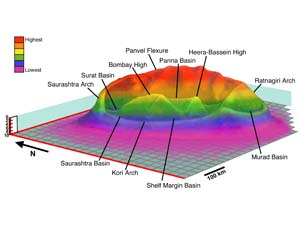
However, many impact advocates have questioned the Chatterjee observations and some, including Christian Koeberl, declare the conclusions to be unproven and possibly erroneous. One problem currently complicating the postulate that Shiva is the main culprit in the K/T extinction is that age dates for it may be different from that for Chicxulub by as much as 30000 years. If this holds up, and Shiva is indeed the largest impact crater on Earth, this would mean that the two biggest such events took place almost (but not quite) simultaneously - a remarkable (but plausible) coincidence.
Now to other craters that could trigger extinction consequences. A report in November, 2003 has presented evidence from rock deposits in Europe and China of a very large impact, about 251 million years ago, that coincides with the end of the Paleozoic (Permian-Triassic boundary), a time in which about 90% of marine species living then are estimated to have vanished - a time now referred to as the "Great Dying". This is the greatest mass extinction in Earth history - it set the stage for a new burst of now different life in the Mesozoic. The hunt for this super crater has been a top priority in the last five years.
Most destruction of life was in the oceans. But reptiles occupying the land also were largely compromised (but not completely wiped out or there would have been no dinosaurs or mammals in the Mesozoic). Among these was Dimetrodon, a reptile with a sail-like dorsal fin, who disappeared completely at the Permian's end.
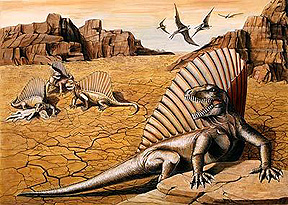
In May 2004 announcement was made that the Permian killer crater may indeed have been found. Marine geophysics surveys off the northwest coast of Australia turned up a distinct anomaly buried under shallow seas that was promising enough to drill two deep holes in search for oil (several impact craters have served as petroleum traps). Here is a seismic refraction survey map that shows the buried structure including its central peak (40 km [25 miles] diameter}.
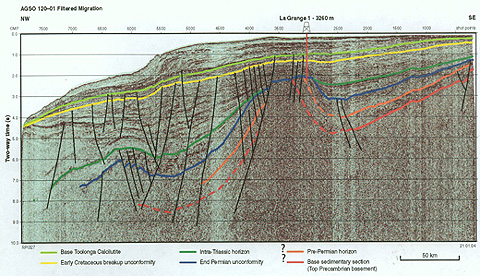
The structure has been identified by Professors Luann Becker (UCSB) and Robert Poreda and Asish Basu (University of Rochester) as an impact structure, and named the Bedout (pronounced "bidowe"; French word) crater. Most of the Bedout images shown on this page were extracted from their online paper (no longer available). The figure below shows the paleogeography at the close of the Paleozoic, in which most continents were grouped together in Pangaea. Bedout lies just off the soon to become Australian block, in shallow waters of the PaleoTethys Ocean.

The yellow-centered circle is the Fraser Park, Australia locality containing what they (and others) interpret to be fallout debris - small fragments of rock and glass. The red dots are other localities - each containing a layer of highly probable impact ejecta containing such evidence as shocked meteoritic chips, glass spherules, Fe-Ni-Si grains, and fullerenes (so-called "buckyballs" made up of carbon arranged in a "geodesic" structure). Note the occurrence of extensive volcanism, the "Siberian Traps". (This outpouring of basaltic lava supports an alternative hypothesis for the demise of so much life, namely the accumulation of harmful gases and particulates in the atmosphere may have created adverse conditions [such as acidic seawater] that diminished life.) Basaltic volcanism also covered the Bedout structure on the sea floor; afterwards about 3 km (2 miles) of mid-Triassic through Cretaceous, and then Tertiary-Quaternary sediments were formed.
This montage of photos shows a land outcrop traceable to the Bedout event, a guide fossil, Glossopteris (a plant), which disappeared immediately afterward, and a grain of quartz which shows planar features - a key indicator of impact as discussed below and on the next page.
In the May 2004 paper, the above mentioned investigators claim to have now found actual pieces of the asteroidal impactor (estimated the size of Mt. Everest) itself. They note too that at the close of the Permian, Australia was part of Pangaea, so the asteroid might have struck on this supercontinent but the land containing the resulting crater has since detached and become buried by marine sediments and ocean water.
Core recovered from the structure, which presently has the dimensions of 200 km (125 miles) but may be even larger, produced fallback breccias in a zone more than 300 meters thick. This was initially interpreted as a volcanic breccia. One core segment shows the recovered breccia with a Chicxulub example along side.
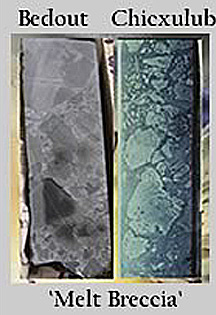
Another group of Bedout cores and core from Chicxulub (bottom) at first glance looks almost like gray sediment of clay or fine-crystalline limestone nature:
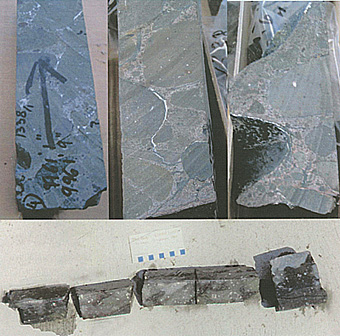
When the Bedout core was examined in detail, the breccia clasts were determined to be mostly made up of largely devitrified glass, containing plagioclase, iron oxides, iron-titanium oxide, and recrystallized chlorite. This is a typical petrographic microscope view of a Bedout clast, which resembles impact melts seen at various accepted impact structures:
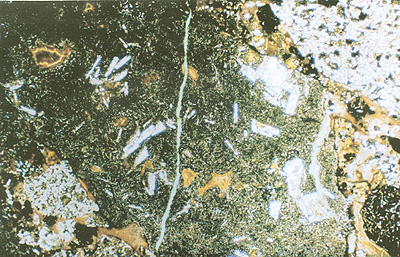
Very strong proof of impact origin for Bedout is the shock metamorphic phenomenon of conversion of plagioclase crystals (as laths) into the glass known as Maskelynite. This is evident in this pair of images showing photomicrographs of a sample in which (in the top view) laths of plagioclase showing a brown tone are set in a crystalline albite (white) and titanite (black) matrix. In the bottom, the laths are now revealed to be totally isotropic (remain dark in crossed-polarized light when the microscope stage is rotated) as bespeaks of a glassy state.
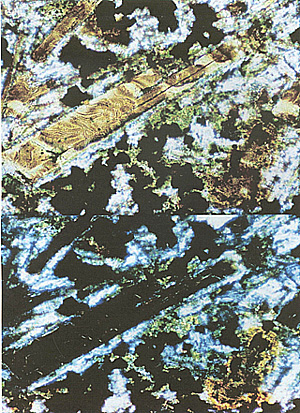
Some Calcium-Magnesium Carbonate material in the core has been converted to glass (this is very rare but was first produced by the writer in an implosion tube experiment). Another indicator of shock at the Bedout site is the "toasted" quartz grains with single to multiple sets of planar deformation lamellae found rarely in the core but more commonly in the fallout layer tied to this event. Here are two examples from the Fraser Park, Sydney basin site:
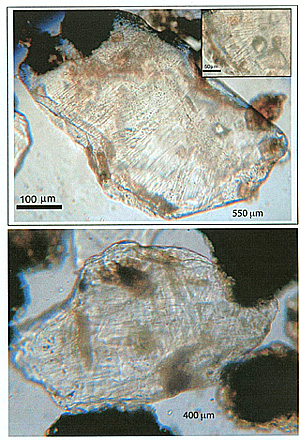
The Becker team and others have done age dating on the core materials from the crater and from fallout layers elsewhere. The Ar40/A39 dating yields ages of 250.1 +/- 1 million years, almost exactly the time assigned to the Permian/Triassic boundary (end of the Paleozoic).
At the moment, several impact specialists have disagreed with the interpretation of the evidence cited so far as proof of an impact origin for Bedout, so the inevitable dispute from multiple interpretations has commenced (the concept of "multiple hypotheses" was first promulgated by a geologist). But the study is just beginning. If proved to be a huge impact, Bedout probably is at least one, and maybe the exclusive, factor in the Great Dying.
As so often happens in Science, just when a definitive answer seems to have been found, something new is discovered that clouds the issue. A competing event, in some ways superior because of size, has been announced as a leading candidate of the Killer Crater. This - as yet unnamed - lies under 1.5 km of ice in Wilkes Land in the Antarctic. The buried structure may be as wide as 500 km (300 miles); indirect evidence suggests it may be about the same age as Bedout (but drilling to sample its rocks will be needed to confirm this). It shows up as a gravity anomaly (mascon; positive mass caused by upward movement of denser subcrustal rocks) and has a crude circular outline. Inspect these three maps:
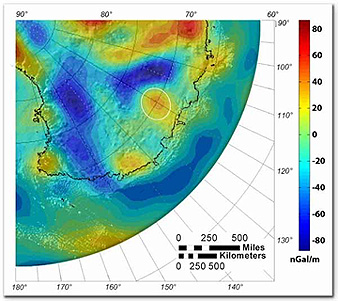

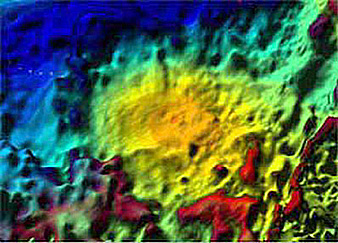
A buried crater under the Chesapeake Bay may have been large enough to kill off some life during the Tertiary. This structure has a diameter of at least 90 km (56 miles), with a central peak. It is located as shown below:
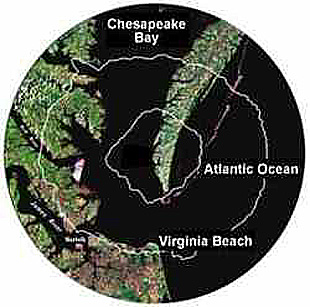
Like some others, the structure was first found during a geophysical survey. It lies buried beneath both coastal and estuarine sedimentary materials. It has been drilled; another drilling is underway. Recovered core shows extensive breccia units. Age dating of these deposits places an age of 35 million years for the breccia matrix. Proof of an impact origin includes telltale planar deformation features in quartz within breccia clasts, as shown here:
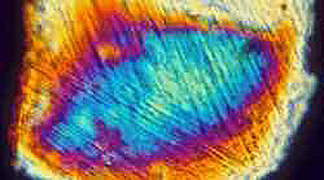
Chicxulub, Chesapeake, Bedout and Wilkes Land are among a growing number of impact structures that are buried and have been discovered during geophysical surveys. Another - almost a type case - is the Ames structure (~13 km diameter) in northern Oklahoma, found when it was picked up by gravity and magnetic surveys and then drilled in search for oil. Here is a cross-section prepared by Prof. Judson Ahern showing the crater, its distribution of materials of different densities, and survey results:
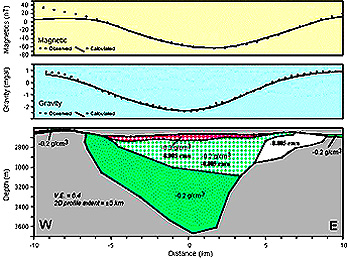
The above proposed impact events extend into geologic time, well before humans entered the evolutionary picture. But the threat of world-level catastrophes owing to impacts has now been accepted as real and concerning. Has there ever been such an event? The answer seems to be 'yes'.
Some 12,900 years before the present, there was a sudden, abrupt disappearance from North America of at least 35 species of large mammals including the Wooly Mammoth, the Saber-toothed Tiger, and the Giant Sloth. Primitive Indians known as the Clovis people also seem to have vanished as a culture. The climate too became colder (about an average of 8 degrees Celsius) and glaciation, already covering most of Canada, expanded. What could have caused this?
Although several explanations have been advanced, the best fit seems to be a comet impact. The Clovis comet, as it has now been named, is proposed as the culprit. There is abundant evidence for a major explosion, either in the atmosphere or in the Canadian ice (no crater resulting from impact has yet been found). A layer, named the Younger Dryan, of black soot, about 4 cm. thick, is found widespread across North America and even into Europe. Here is an outcrop in Arizona with this layer:
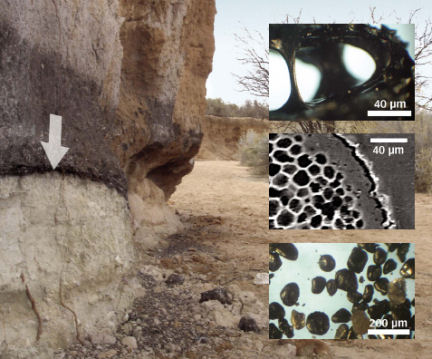
The layer contains several hallmarks of impact, including iridium anomalies, nanometer diamonds, and fullarenes. The iridium spikes are not as pronounced as those associated with the K-T boundary /layers.
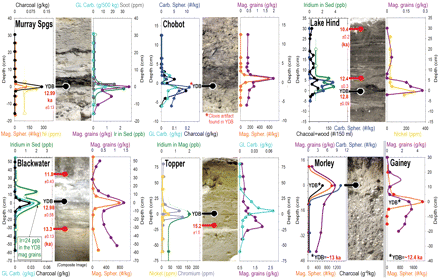
The spherules are distinctive, as shown here:
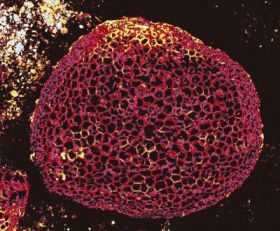
The diamonds are typical from 10 to 100 nanometers in width. Their crystal structure is hexagonal, not the isometric diamonds found in intrusive pipes on Earth; hexagonal diamonds are known only from settings that involve shock pressures, such as impacts.
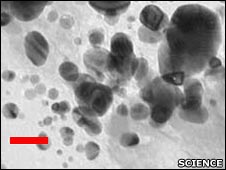
These diamonds have unique signatures when examined by transmission electron microscopy:
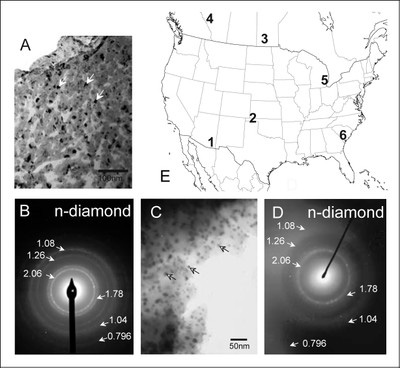
But as is usually the case in Science, hypotheses as "outrageous" as killer impacts have their challengers. Despite models that show how an impact crater hundreds of kilometers in diameter could affect the atmosphere and surfaces worldwide, there are those still skeptical of this mechanism. These scientists propose other reasons for mass extinction, chief of which is intense regional to worldwide volcanism which at its height could saturate the atmosphere with light-blocking ash and moisture.
So, where does the scientific community stand on the general topic of mass extinctions, both from the standpoint of impacts and the other possible causes of disappearance of entire classes of animals and plants. Comments above indicate that there is a difference of opinions about the actual reason why the dinosaurs did not survive past the K-T boundary. Whether this was due to one short-lived event or was the result of a set of circumstances spread over a gradual period of time is still being debated. Multiple explanations have been proposed. This chart is the plot of a survey among involved scientists as to the primary cause as well as possible secondary or multiple causes:
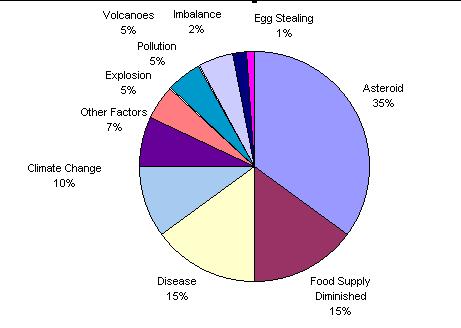
The impact hypothesis remains the currently favored cause of the extinction that prevailed at and after the K-T boundary layer was deposited. But, the mechanisms responsible for the extinction are still being debated. Some scientists claim they have found contradictory evidence pertaining to proposed causes. For instance, if global fires were instigated by the fallout from the impact, the atmosphere would have held huge quantities of soot that would lead to deposits of charcoal in the boundary layer. In fact, only traces of charcoal are present. Therefore, such extensive fires seem unlikely. Again, atmospheric chemistry would have been affected by the impact, with some models leading to acid rain, which would have severely stressed vegetation. But evidence for this is inconclusive. Various models result in the possibility of overall cooling and/or warming (in succession) of the atmosphere. This is to be expected from the vast amounts of dust particulates that an impact would eject into the atmosphere. So, once more the evidence is frought with uncertainty for either modification of temperatures. The presence of fern remnants just above the boundary layer is consistent with the postulate that, although vegetation was severely diminished by whatever was happening to the environment after the K-T event, plant life bounced back rapidly. Animals - mainly small mammals - also reappeared soon thereafter, as these apparently survived the adverse effects in the global environment. Needless to say, much more research must be done to resolve these anomalies.
Another "bone of contention" is whether a Chicxulub-sized crater tosses enough material into the atmosphere to have had a global influence. To go global would require efficient transportation and distribution by the atmospheric circulation system operating at the time. In today's world, the present circulation would likely not carry particulates across the globe; transportation into the southern hemisphere from a northern hemisphere event would be difficult. In the writer's opinion, this is a major stumbling block to the idea that the Chicxulub impact (for which the evidence is very solid) was the sole cause of the general extinction that did happen. It seems more likely that there were other contributing factors. One, often cited, is the likelihood of extensive atmospheric contamination by chemicals (including sulphur compounds) introduced from the vast outpourings of lava that formed the Deccan Traps (basaltic flows) of India. These lava deposits extend over much of the Indian subcontinent and the sea floor to the west, as depicted in this diagram:
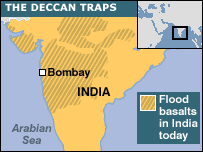
Another problem with the Chicxulub model may have merged. Examine this diagram.
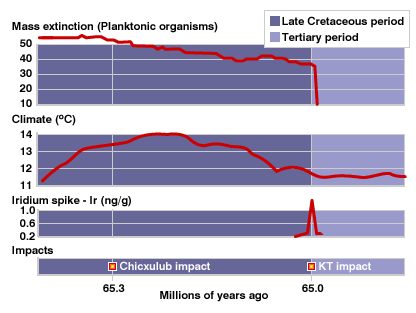
The bottom chart is our "talking point". A group of scientists who are studying the Chicxulub material obtained through drilling have acquired radioactive dates from the volcanic rocks that indicate the rocks are 300000 years older than the K-T boundary layer age. If this is valid (but the error range for the dating might overlap the two ages), then the implication is that there were two separate large impacts closely spaced in geologic time - not impossible, but not of high likelihood.
There is another, perhaps more imposing, objection to impact as the main reason for dinosaur (and other animals) extinction. This is the mounting evidence that the dinosaurs were faced with adverse conditions over millions of years prior to the K-T event which were making their environment increasingly unstable. Evidence in upper Cretaceous rocks show a general trend of aridity (desertlike conditions) across much of the world. If this indeed did happen, it could account for the decrease in the number of dinosaur species observed in Cretaceous rocks prior to the K-T event. So, the dinosaurs were being stressed and heading for extinction anyway, according to some views. The impact(s) at the close of the Cretaceous would have some (probably serious) influence on the dinosaur demise - they would have administered the "coup de grace", but were not the sole cause.
The most frequently cited alternative to impact as the primary cause of mass extinctions is significant volcanism. Although stratocone eruptions can introduce a wide variety of toxic gases into the upper atmosphere, these tend to be localized and of short duration - one at a time. Flood basalts cover a much wider expanse, and calculations show that the amount of gases from such long-lasting events will contaminate the atmosphere (probably globally) to a much higher degree. This next diagram plots extinction events and major flood basalt volcanism:
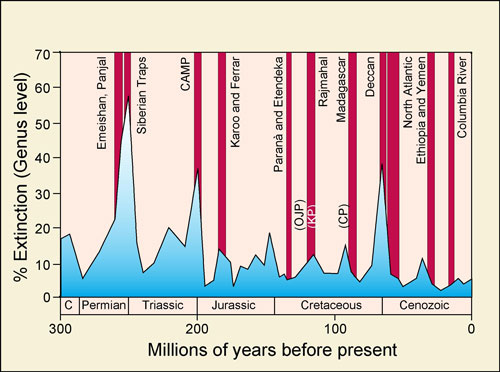
It is evident that there is some definitive correlation - at least some volcanism on a grand scale occurred during periods of mass extinction. This diagram shows the geographic location of major flood basalt outpourings, along with other extensive volcanic deposits:
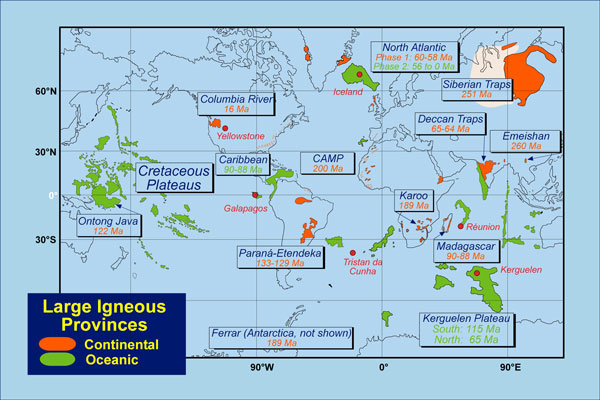
But keep in mind that the distribution of continents was much different in past times. For the calamitous Permian extinction event, the Siberian Trap basalts - which many believe were the prime cause of the extinction - were located in the northern part of the supercontinent Pangaea.
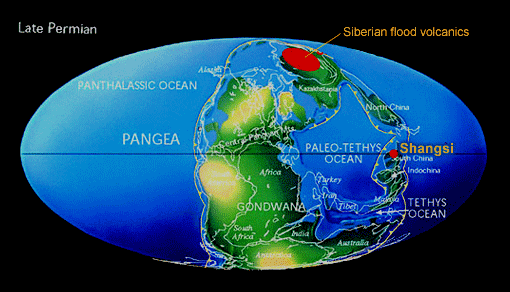
Details of the Siberian Trap deposits are evident in this map:

The Siberian Trap basalts cover a large area of north-central Siberia. We saw a Landsat image showing Trap terrain in Section 6. The image used there is repeated here:
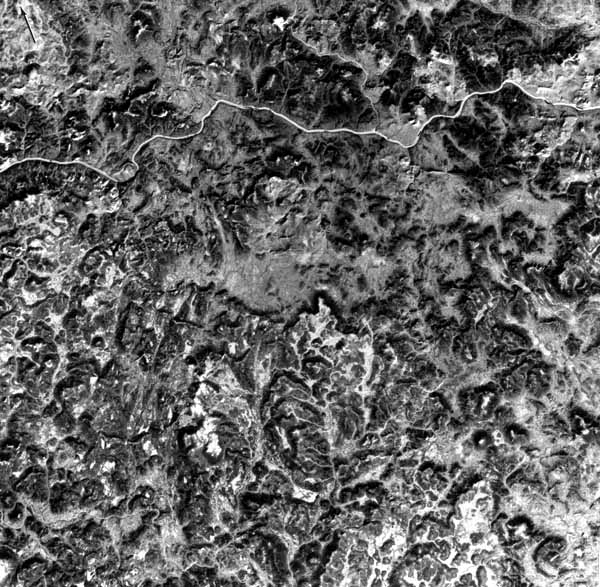
Two websites bearing on the Siberian Traps are found at Wikipedia and University of Glouchester (be sure to click on "Volcanism").
So, in sum: Like the K-T extinction, the cause(s) of the other extinctions is still being debated. Large impacts certainly can be detrimental to the animal and plant species of the time. But volcanism, climate change, and other factors must be considered. However, the mechanism that is most likely to force the various environments at any given time into "catastrophe mode" is worldwide atmospheric contamination that brings about temperature and precipitaton modifications so drastic that a multitude of species cannot adapt. Impact and subcontinental scale volcanism are the two causitive leaders.
A good treatment of the K-T event, with links to web sites that consider mass extinctions is presented on the reliable Wikipedia K-T Extinction and Mass Extinction Internet connections.
Now that you are familiarized with the general appearance of impact craters and their possible role in influencing life on Earth, we next will consider the best evidence for proof that a circular structure has been caused by a cratering event - shock metamorphism.
